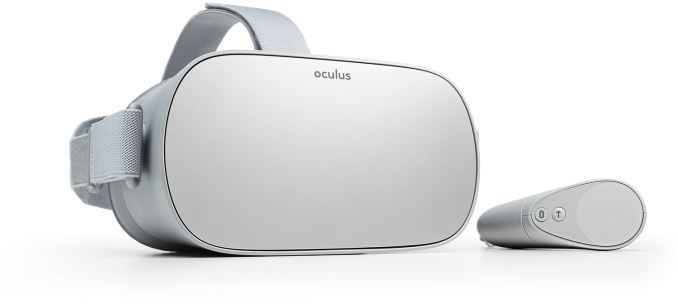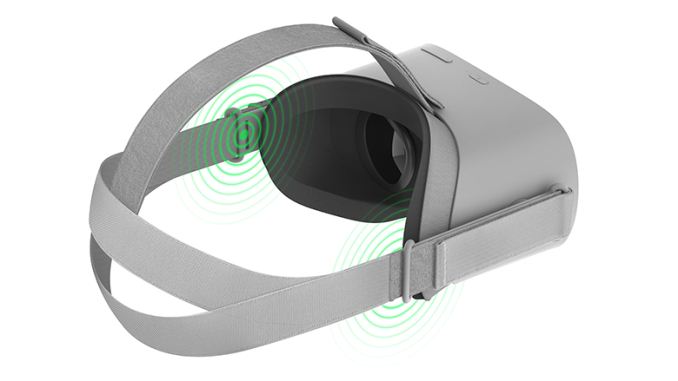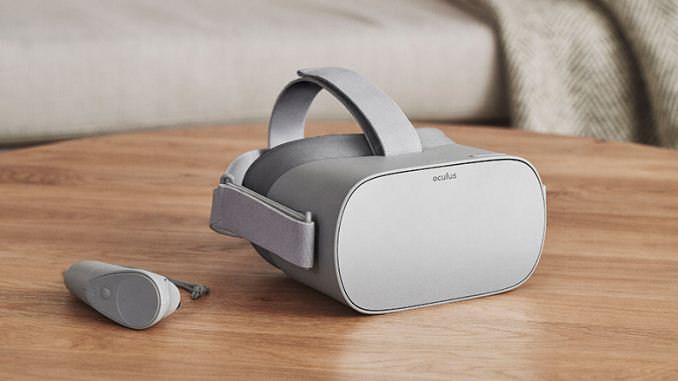Oculus Announces Oculus Go: Untethered VR For $199 USD
by Brett Howse on October 11, 2017 9:30 PM EST
Today, Facebook owned Oculus announced their follow up to the Oculus Rift VR headset, and they’ve decided to make the entry point to Oculus VR much easier to access. At $199, the new Oculus Go is significantly undercutting the $599 launch price of the Rift, which has seen its own price cut to $399 since it launched about a year and a half ago. But the Go is not just a less expensive version of the Rift. It’s a self-contained VR system, providing untethered VR capabilities.
Despite the lower price, the Go has a higher resolution display than the Rift. The Go features a 2560x1440 “Fast-switch” LCD display, which is a bump up from the 2160x1200 combined resolution of the two OLED displays in the Rift. Fast-Switch likely means a higher refresh rate, but no specifications have been announced yet to see how it compared to the 90 Hz of the Rift. Oculus is also promoting the optical lenses are new and improved for the Go, offering a wider field of view and less glare. The LCD display and new lenses should help with the screen door effect that is present on VR headsets, but we’re still a long way from having the processing power to remove this completely.
Oculus Go also includes integrated spatial audio, which is one of the big features Oculus promoted on the Rift when it launched. The speakers are built-in to the sides of the headset, so no extra equipment is necessary. They have had the courage though to add a 3.5mm headphone jack, if you want to listen privately.
Go and Gear are "binary compatible" so any apps that work on Gear, should work on Go. It's helpful to have an ecosystem when you're launching a new product.
The new headset is made of a new breathable cloth, for improved comfort, and the Go can be used with glasses.
Unlike the Rift, the untethered nature of the Go means that it won’t have the full tracking capabilities, but that can be a benefit as well since not everyone has a dedicated location they can leverage VR. At the outset, the Go seems like a well priced, capable VR headset, and although it won’t have the gaming potential of a full PC behind it, the capabilities of a smartphone SoC have been improving dramatically over the years. Unfortunately Facebook / Oculus hasn’t announced what is actually powering the Go, so we’ll have to wait and see how much performance they can get for $199. Tomshardware is reporting it's a Snapdragon 821.
The Oculus Go ships early next year.
Source: Oculus Blog















28 Comments
View All Comments
haukionkannel - Thursday, October 12, 2017 - link
There will be Also more expensive 835 version. So different products to different price gategories. Just like in phones.jjj - Wednesday, October 11, 2017 - link
SD821 might be less than great on the CPU side but it's not about the CPU here and it's more than fine at this price point.at80eighty - Thursday, October 12, 2017 - link
They have had the courage though to add a 3.5mm headphone jacklol
prisonerX - Thursday, October 12, 2017 - link
Yes, sooooooo much courage required to add a headphone jack to a product the size of a house brick...But besides privacy and consideration for others, the idea of not having anything on your ears is a good one, since you can hear your surroundings and you don't get ear fatigue.
Would be nice if some headphone makers explored this sort of design.
at80eighty - Thursday, October 12, 2017 - link
the idea of not having anything on your ears is a good one, since you can hear your surroundings and you don't get ear fatigue.Would be nice if some headphone makers explored this sort of design
um. ever heard of speakers?
prisonerX - Wednesday, October 18, 2017 - link
Thanks for the idiotic reply. Congrats.edzieba - Thursday, October 12, 2017 - link
"Fast-Switch likely means a higher refresh rate"Not higher refresh rate (90Hz is nothing unusual for LCD), but faster worst-case pixel switching time. For low-persistence driving (e.g. 'Lightboost') you must wait for ALL pixels to complete switching before pulsing the backlight, or you'll illuminate pixels that are still changing colour. At 90Hz, the difference between illuminating at the start of the refresh interval (e.g. OLED) or at the end of the refresh interval (e.g. LCD) is 11ms, or OVER HALF of your motion-photons budget potentially wasted on waiting of hardware (and worse, 11ms injected AFTER the final post-warp orientation sampling).
valinor89 - Thursday, October 12, 2017 - link
So... can I have this but with a cable I can connect to my computer? I don't need all the bells and wistless that the oculus rift has, just a bit of head tracking and a decent display to strap on my face that can use the compute power of my Desktop computer. I don't need room tracking and I definitelly don't need it to play on the go.I just want the original (MK1) Oculus rift capabilities with a decent display without having to pay 600€.
06GTOSC - Thursday, November 9, 2017 - link
Indeed. If you want to play driving games or flight games with a headset, you don't need anything beyond head tracking so you can look around.JoeyJoJo123 - Thursday, October 12, 2017 - link
"They have had the courage though to add a 3.5mm headphone jack..."Never thought I'd see the day when a device including a 3.5mm jack for stereo sound support would be seen as courageous. Well thanks anyways Fakebook for including what should be a default "feature" anyways.